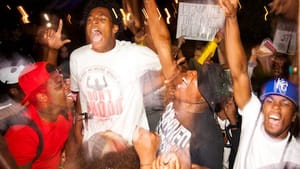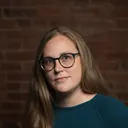Stay in the Loop
BSR publishes on a weekly schedule, with an email newsletter every Wednesday and Thursday morning. There’s no paywall, and subscribing is always free.
The language of the unheard
BlackStar Film Festival presents Sabaah Folayan and Damon Davis's 'Whose Streets?'

A nighttime storm drenches Ferguson, Missouri. A camera rides in the back seat as a pair of black men drive past traffic and streetlights in the rain, colors smearing the windshield. “I don’t know what year it is,” one of them says, “but it’s not 2014.”
Whose Streets?, from filmmakers Sabaah Folayan and Damon Davis, received its Philadelphia premiere at the sixth annual BlackStar Film Festival. The sold-out screening was a wrenching, absorbing, indelible 90 minutes, immersing the audience in the aftermath of the fatal August 9, 2014, shooting of Michael Brown, an unarmed black teenager, by Ferguson police officer Darren Wilson.
Told in five segments denoted by blood-red Roman numerals on a black screen, the film’s chapters are paired with quotations from figures such as Rev. Dr. Martin Luther King Jr., Dr. Maya Angelou, and Sojourner Truth.
The language of the unheard
The film’s first chapter is accompanied by Dr. King’s words, “A riot is the language of the unheard.” Later, as the film explores the convulsions of miscarried justice, it’s Langston Hughes:
That Justice is a blind goddess
Is a thing to which we black are wise:
Her bandage hides two
festering sores
That once perhaps were eyes.
From its start, Whose Streets? includes on-the-scene citizens’ video footage, beginning with groups of dazed locals who try to fathom why Brown’s body lay in the street for four and a half hours. Mixed with this footage are interviews, national TV-news excerpts, social-media snapshots, and intimate domestic scenes revealing the family lives of front-line activists.
It’s a tightly balanced yet unflinching blend. More important, it reveals the lie of Ferguson narratives that depict the city slipping overnight into a nightmare of flagrant violence and a justified advance of militarized police.
Locals’ stories alternate with harrowing, chaotic, firsthand views of the burgeoning protests and riots. To them, the tensions that snapped after Brown’s killing were not an unwarranted and unpredictable response but an almost inevitable overflow of rage at decades of deep-rooted, systemic oppression and fear.

In mid-August 2014, the St. Louis Post-Dispatch cited arrest data from the attorney general’s office showing that in 2013, of 5,384 traffic stops in Ferguson, 4,632 involved black drivers, while just 686 were of white drivers. Black people were almost twice as likely to be searched by police, even though more white people were found with contraband. With a population that was 67 percent black, only three members of Ferguson’s 53-officer police force were black.
Revolutionary acts
The documentary frames widely denounced scenes of burning and looting with one activist’s definition of violence as something that injures or kills people.
“A building burning is worse than a black person getting shot,” she says of the status quo that values property over black bodies. “A building is a building. That’s a revolutionary act. That’s strategic,” she says of the flames. A convenience store can be rebuilt. Nothing can bring a murdered person back to life.
The documentary gives a frontline view of more than a year of life in Ferguson. Among the events are early vigils and marches, an October youth uprising drawing protesters from across the country, the wait for the grand jury’s decision on Wilson’s indictment, the Justice Department investigation into Ferguson’s police force, and what locals who refused to be silent did next. Through it all we see the effort to maintain an on-site memorial for Brown.
Cellphone footage from countless citizen vantage points documents the raw terror, disbelief, and blazing defiance locals felt as police and National Guard troops advanced in riot gear, wielding guns, rubber bullets, and tear gas. News reports refer to unarmed protesters as “insurgents,” as President Obama claimed Ferguson was still under local jurisdiction.
Cameras, signs, and voices
“All this is chemical warfare, which you’re not supposed to use on U.S. soil,” says one activist, displaying the smoke and tear-gas canisters he finds on the street. “Signs. That’s all they got,” he says of the citizens facing this military-grade force. “My camera, that’s my weapon,” he adds of his own mission to document police brutality.
The film also follows Brittany Ferrell, a young black mother and aspiring nurse practitioner who emerges as one of the protest’s key figures. We meet her daughter and wife, and see her terror that her violent arrest at a road-blocking protest will lead to a felony conviction. In one of the film’s most riveting moments, she faces down an advancing line of cops who suddenly disperse under her steely eyes.
The film also includes excerpts of a primetime George Stephanopoulos interview with Wilson, who insists on comparing Brown to “a demon” in the moments before Wilson killed him. He also declares, “You can’t perform the duties of a police officer and have racism in you.” At that, BlackStar’s audience erupted in a deafening bark of derisive laughter.
By its end, Whose Streets? finds hope and even fiery jubilance in the emergence of the next generation of activists.
“If you are not questioning ‘normal,’ you are not paying attention,” Ferrell says.
What, When, Where
Whose Streets? Sabaah Folayan and Damon Davis directed. August 3, 2017, at the Lightbox Film Center, 3701 Chestnut Street, Philadelphia. (267) 603-2755 or blackstarfest.org.
Opens August 11, 2017, at the Ritz at the Bourse, 400 Ranstead Street, Philadelphia. Philadelphia area showtimes.
Sign up for our newsletter
All of the week's new articles, all in one place. Sign up for the free weekly BSR newsletters, and don't miss a conversation.
 Alaina Johns
Alaina Johns